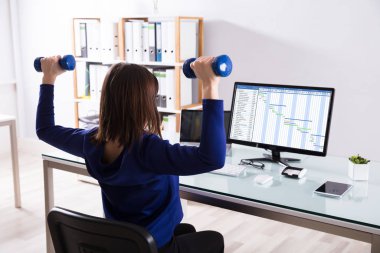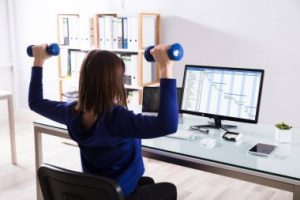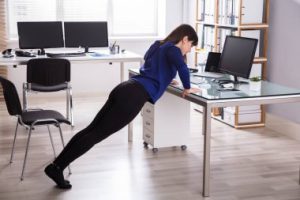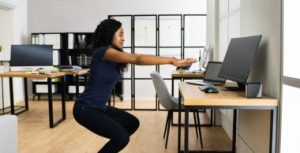
Exercises I Can Do At Work (5 Important Exercises)
Exercises I can do at work include desk stretches and chair yoga to keep your body active and reduce stress. Incorporating these simple movements into your daily routine helps improve your posture and overall well-being. Imagine transforming your workday from mundane to invigorating with simple, effective exercises that seamlessly integrate into your office routine.
Whether you’re tethered to a desk, confined to meetings, or constantly on the move, discover how a few strategic movements can enhance your productivity, boost your energy levels, and improve your overall well-being. From discreet chair stretches to dynamic deskercises, these workplace workouts are designed to keep you fit, focused, and feeling fabulous—all without leaving your office!

Exercises I Can Do At Work
Incorporating exercises at work can boost productivity and reduce stress. Simple activities like desk stretches, seated leg lifts, and chair squats can make a big difference. These exercises are easy to do and require minimal space. They help improve posture and alleviate discomfort from prolonged sitting. You can seamlessly integrate them into your workday.
Stretching at Your Desk
Stretching at your desk can counteract the negative effects of sitting for long hours. Common desk stretches include shoulder shrugs, neck rotations, and wrist flexor stretches. These movements help increase blood flow, reduce muscle tension, and prevent repetitive strain injuries. By incorporating these stretches into your routine, you can enhance flexibility and maintain a comfortable working posture. Stretching also helps clear your mind, making you feel more alert and focused.
Seated Leg Lifts and Extensions
Seated leg lifts and extensions are great for engaging your lower body muscles without leaving your chair. To do a leg lift, sit upright, extend one leg straight out, and hold it for a few seconds before lowering it. Repeat with the other leg. This exercise strengthens your quadriceps and improves circulation. Adding ankle rotations can further enhance joint mobility. Performing these exercises regularly can help prevent stiffness and promote better overall leg health.
Chair Squats and Standing Desk Options
Chair squats are an effective way to activate your glutes and quads while at work. To perform a chair squat, stand in front of your chair, lower yourself as if you’re going to sit, and then stand back up. Repeating this several times can increase your heart rate and strengthen your lower body. For those who have access to a standing desk, alternating between sitting and standing can reduce the risk of back pain and improve posture. Standing desks encourage movement and can lead to higher energy levels throughout the day.
Walking Meetings and Taking the Stairs
Walking meetings are a dynamic way to integrate physical activity into your work routine. Instead of sitting in a conference room, suggest a walk-and-talk session with colleagues. This not only gets you moving but also stimulates creativity and collaboration. Additionally, opting for the stairs instead of the elevator is an easy way to incorporate more movement into your day. Climbing stairs strengthens your legs, boosts cardiovascular health, and can be a quick way to rejuvenate during a work break.
Benefits of Workplace Exercise
The benefits of workplace exercise extend beyond physical health. Regular movement can lead to better mental clarity, reduced stress levels, and increased overall job satisfaction. By making small adjustments and integrating simple exercises into your workday, you can create a healthier, more productive work environment. Employees who stay active tend to report higher energy levels, better focus, and improved mood. Incorporating these exercises into your daily routine can contribute to long-term health and well-being.

Desk Exercises
Stretching
Desk exercises are essential for maintaining physical well-being, especially for individuals who spend prolonged hours sitting at a desk. Incorporating simple stretches can help alleviate discomfort and prevent potential musculoskeletal issues. One effective desk exercise is the neck stretch: sit upright and gently tilt your head towards one shoulder, holding the position for 15-30 seconds before repeating on the other side. This stretch helps release tension in the neck and upper back.
Another valuable stretch is the shoulder stretch: bring your right arm across your chest and use your left hand to press it towards your chest, holding for 15-30 seconds, and then switch sides. This exercise targets the shoulders and upper back, helping to reduce stiffness and improve flexibility.
Lastly, the wrist stretch is crucial for those who frequently use keyboards and mice. Extend one arm forward with the palm up, and gently pull back on the fingers with the other hand, holding for 15-30 seconds before repeating with the other hand. This stretch helps prevent carpal tunnel syndrome and alleviates wrist and forearm strain. By integrating these simple yet effective stretches into your daily routine, you can enhance your comfort, productivity, and overall health while working at a desk.

Strengthening
One effective exercise is chair squats, which help strengthen your lower body. To perform chair squats, stand in front of your chair with your feet shoulder-width apart. Slowly lower yourself as if you’re about to sit down, making sure your thighs are parallel to the floor. Hold the position briefly, then rise back to a standing position. Aim to repeat this movement 10-15 times.
Another excellent desk exercise is seated leg lifts, which target your core and hip flexors. Sit up straight in your chair, extend one leg out in front of you, and hold it in the lifted position for 5 seconds. Lower the leg back down and repeat with the other leg. Perform this exercise 10-15 times per leg to enhance your strength and endurance. Incorporating these exercises into your routine can improve your posture, reduce the risk of developing sedentary-related ailments, and boost overall productivity by keeping your body active and engaged.
Mobility
Incorporating desk exercises into your daily routine is an excellent way to combat the negative effects of prolonged sitting and improve overall mobility. Two effective exercises for enhancing mobility are ankle rolls and seated marches. Ankle rolls involve sitting with one leg crossed over the other and rotating your ankle in circular motions, both clockwise and counterclockwise, for 30 seconds per ankle. This simple movement helps maintain flexibility in the ankle joints, improves circulation, and can prevent stiffness and discomfort associated with long periods of inactivity.
Seated marches, on the other hand, are performed by sitting tall and lifting one knee towards your chest, then alternating legs in a marching motion. This exercise should be continued for 1-2 minutes and is great for engaging the hip flexors, promoting blood flow to the lower extremities, and maintaining the flexibility and strength of the hip and knee joints. Both exercises can be easily performed at your desk without requiring any special equipment, making them convenient options for anyone looking to stay active and healthy throughout their workday. By regularly incorporating these movements, you can counteract some of the adverse effects of sitting and support better overall mobility and well-being.
Office Space Exercises
Cardio
Office space exercises are an excellent way to incorporate physical activity into a typically sedentary workday, enhancing both physical health and productivity. Cardio exercises can be seamlessly integrated into office routines, starting with walking meetings. These meetings, designed to be conducted while walking around the office, not only promote physical activity but also often lead to more dynamic and creative discussions. Aim to schedule walking meetings for 10-15 minutes, ensuring a healthy break from sitting while still maintaining productivity.
Another effective cardio exercise is stair climbing. Opting for the stairs instead of the elevator can significantly increase daily physical activity. Additionally, taking 5-10 minute breaks to climb a few flights of stairs throughout the day can help elevate heart rate, improve cardiovascular health, and break the monotony of sitting at a desk for extended periods. Incorporating these simple yet effective cardio exercises into the daily office routine can lead to improved overall well-being, reduced stress levels, and enhanced work performance.
Strengthening
Office space exercises can be an excellent way to integrate physical activity, promoting overall health and reducing the risk of musculoskeletal issues. Among the various exercises that can be performed in an office setting, desk push-ups and wall sits are particularly effective for strengthening different muscle groups. Desk push-ups are a convenient exercise that targets the upper body, including the chest, shoulders, and triceps. To perform desk push-ups, stand a few feet away from your desk and place your hands on the edge. Lower your chest towards the desk, maintaining a straight line from head to heels, and then push back up to the starting position. This exercise can be repeated 10-15 times to effectively work the upper body muscles.
On the other hand, wall sits are an excellent exercise for building lower body strength, particularly targeting the quadriceps, hamstrings, and glutes. To perform wall sits, stand with your back against a wall and slowly slide down until your thighs are parallel to the floor, as if sitting in an invisible chair. Hold this position for 30-60 seconds, making sure your knees are directly above your ankles and your back remains flat against the wall. Incorporating these exercises into your daily routine can help break up long periods of sitting, improve muscle tone, and contribute to overall physical well-being.

Flexibility
Office space exercises can significantly enhance flexibility and reduce discomfort caused by prolonged sitting. Incorporating stretches like the Standing Hamstring Stretch can be particularly beneficial. To perform this stretch, place one foot on a low chair or desk, keeping your back straight as you lean forward from the hips. This position should be held for 15-30 seconds before switching to the other side, effectively loosening tight hamstrings.
Another excellent exercise is the Quad Stretch. Stand on one leg and pull the other foot towards your buttocks, holding your ankle for balance. Maintaining this stretch for 15-30 seconds on each leg can help relieve tension in the quadriceps and improve overall leg flexibility. These simple yet effective exercises can be seamlessly integrated into your office routine, providing a quick and efficient way to maintain flexibility and counteract the physical strains of desk work.
Break Time Exercises
Quick Workouts
Incorporating break time exercises into your daily routine can significantly enhance your physical and mental well-being, particularly if you have a sedentary job. Quick workouts, such as jumping jacks and burpees, are effective ways to get your heart rate up and invigorate your body and mind during short breaks. Jumping jacks, which involve jumping to a position with the legs spread wide and the hands touching overhead, then returning to a position with the feet together and the arms at the sides, can be performed for 1-2 minutes. This simple yet dynamic exercise helps to increase cardiovascular fitness, improve coordination, and engage multiple muscle groups.
On the other hand, burpees are more intense and full-body exercises that combine a squat, jump, and push-up. Performing 10-15 repetitions of burpees can effectively build strength and endurance, as well as enhance agility and flexibility. These quick workouts not only provide a burst of physical activity but also help to break the monotony of prolonged sitting, boosting energy levels, and improving overall productivity. Incorporating such exercises into your routine can contribute to better health and a more balanced lifestyle.

Yoga Poses
Break time exercises can be a refreshing way to rejuvenate both mind and body during a busy day. Among these exercises, incorporating yoga poses can be particularly beneficial. For example, the Tree Pose is an excellent way to improve balance and focus. To perform this pose, stand on one leg and place the sole of the other foot on the inner thigh of your standing leg. Ensure your pelvis is in a neutral position, and bring your hands together in a prayer position at your chest or raise them above your head. Balance here for about 30 seconds, then switch sides to give both legs equal work.
Another effective pose for break time is the Forward Fold. Start by standing with your feet hip-width apart. Slowly bend forward at the hips, letting your upper body and arms hang down towards the floor. This pose stretches the hamstrings, calves, and back muscles while promoting relaxation. Hold this position for 15 to 30 seconds, breathing deeply to enhance the stretch and release tension. These simple yoga poses can help alleviate stiffness, improve circulation, and bring a sense of calm and clarity, making them perfect for short breaks throughout the day.
Core Exercises
Core exercises, in particular, are highly beneficial as they target the muscles in your abdomen, lower back, and pelvis, which are crucial for maintaining good posture and overall stability. One highly effective core exercise is the plank. To perform a plank, you hold your body in a straight line, supported only by your forearms and toes, for 30-60 seconds. This simple yet challenging position engages multiple muscle groups, including the abs, back, shoulders, and legs, making it an excellent full-body workout.
Another great core exercise is the seated ab twist. To do this exercise, sit on the ground with your feet slightly lifted off the floor and your knees bent. Hold your hands together and twist your torso from side to side, bringing your hands toward the floor on each side. This movement, repeated for 1-2 minutes, intensely works the oblique muscles, which are vital for rotational movements and overall core strength. Incorporating these exercises into your break time can help improve your physical fitness, reduce stress, and boost your energy levels, making you feel more alert and productive throughout the day.

Mindfulness and Relaxation
Breathing Exercises
Mindfulness and relaxation are essential practices for maintaining mental and physical well-being. One effective method to achieve this is through breathing exercises, which help calm the mind and reduce stress. A simple yet powerful technique is deep breathing. To begin, sit comfortably in a quiet place. Take slow, deep breaths, inhaling through your nose for a count of four seconds, holding the breath for another four seconds, and then exhaling slowly through your mouth for four seconds. This rhythmic breathing pattern helps to slow down your heart rate and promotes a sense of calm. Repeat this cycle for one to two minutes, focusing on the breath and the sensations it creates in your body.
Another beneficial technique is progressive muscle relaxation, which involves tensing and then relaxing different muscle groups in a systematic manner. Start by focusing on your toes, tensing the muscles for a few seconds before releasing the tension. Gradually work your way up through your body, including your legs, abdomen, chest, arms, and finally your head, tensing and relaxing each group. This practice not only helps release physical tension but also fosters a deeper awareness of your body, contributing to overall relaxation and mindfulness. Incorporating these practices into your daily routine can significantly enhance your ability to manage stress and improve your overall sense of well-being.
Meditation
Mindfulness and relaxation meditation are practices that promote mental clarity, emotional balance, and a sense of calm. Mindfulness involves paying deliberate attention to the present moment, acknowledging thoughts and feelings without judgment. This practice can be enhanced through guided meditation, where a narrator leads you through a series of calming visualizations and breathing exercises. Using a meditation app for a 5-10 minute guided session can be particularly helpful, as these apps offer a variety of meditations tailored to different needs, whether you are looking to reduce stress, improve focus, or simply unwind.
One such practice within these apps is mindful sitting, where you sit quietly, focusing on your breath or a chosen mantra. This practice allows you to become more aware of your body’s sensations and your mental state, fostering a deeper connection with yourself. By practicing mindful sitting for just 5-10 minutes each day, you can develop a habit of mindfulness that permeates your daily life, helping you to approach situations with greater calm and clarity.
Team Activities
Group Stretching Sessions
Incorporating team activities such as group stretching sessions and scheduled breaks into the daily routine can significantly enhance workplace wellness and productivity. Organizing group stretching sessions during breaks fosters a sense of camaraderie and teamwork, providing employees with an opportunity to connect and rejuvenate. These sessions can be tailored to follow a set routine, focusing on different body parts to ensure a comprehensive stretch that alleviates the tension accumulated from prolonged periods of sitting or repetitive tasks.
By systematically targeting various muscle groups, employees can experience improved flexibility, reduced muscle stiffness, and a lower risk of work-related injuries. Scheduled breaks, punctuated with these stretching routines, not only promote physical well-being but also contribute to mental clarity and reduced stress levels. This holistic approach to workplace health helps in maintaining high energy levels and sustained focus, ultimately leading to increased productivity and a positive work environment.
Team Sports or Activities
Incorporating team sports and recreational activities into the office environment can significantly boost team morale and overall well-being. Implementing fitness challenges, such as tracking step counts or organizing stair climb competitions, encourages employees to stay active and healthy while fostering a sense of camaraderie. These challenges can be designed to accommodate various fitness levels, ensuring that everyone can participate and benefit.
Additionally, introducing recreational games like ping pong or mini-golf during breaks provides a fun and engaging way for colleagues to unwind and interact outside of work tasks. These light sports activities not only serve as a pleasant diversion but also promote a more relaxed and cohesive work atmosphere. By integrating such activities into the work routine, organizations can enhance employee satisfaction, encourage teamwork, and contribute to a more dynamic and enjoyable workplace environment.
Frequently Asked Questions (FAQ) about Exercises I Can Do At Work
Q1: Can I really exercise effectively at my desk?
A1: Absolutely! Desk exercises like seated leg lifts, seated marches, and even simple stretches can help improve circulation, reduce muscle stiffness, and boost your energy levels without requiring a lot of space or equipment.
Q2: What are some quick stretches I can do without leaving my workspace?
A2: You can try wrist stretches by extending your arm and gently pulling your fingers back with the opposite hand. Shoulder shrugs, neck tilts, and seated spinal twists are also great options to relieve tension and improve flexibility.
Q3: How can I fit in a full-body workout during my lunch break?
A3: Utilize bodyweight exercises that require minimal space, such as push-ups, squats, lunges, and planks. You can also incorporate resistance bands for added intensity. Aim for a circuit format to keep your heart rate up and maximize the benefits in a short time.
Q4: Are there exercises I can do while on a conference call?
A4: Yes! Try standing calf raises, seated leg lifts, or even subtle glute squeezes. These exercises can be done discreetly and help keep your muscles engaged during long calls.
Q5: How can I improve my posture while sitting at my desk?
A5: Focus on core-strengthening exercises like seated pelvic tilts and seated knee-to-chest raises. Additionally, make sure your chair and desk are ergonomically set up to support a healthy posture.
Q6: Can I do cardio exercises at work without a treadmill or large space?
A6: Definitely! You can perform high knees, marching in place, or even take brisk walks around your office. For a more intense cardio burst, try stair climbing or jumping jacks if space allows.
Q7: How often should I take breaks to stretch or move around?
A7: It’s recommended to take a short break every 30 to 60 minutes. Stand up, stretch, and move around to reduce the risk of stiffness and improve overall circulation.
Q8: Are there any exercises that can help reduce eye strain from screen time?
A8: Yes! Practice the 20-20-20 rule: every 20 minutes, look at something 20 feet away for at least 20 seconds. You can also do eye exercises like rolling your eyes in different directions or gently massaging your temples and the area around your eyes.
Q9: How can I stay motivated to exercise at work?
A9: Set reminders on your phone or computer to prompt you to take exercise breaks. Partner with a colleague to do exercises together, turning it into a social activity. Keeping a set of small exercise equipment, like resistance bands or a stability ball, at your desk can also serve as a visual reminder.
Q10: Can I incorporate mindfulness into my office exercise routine?
A10: Absolutely. Combine stretching with deep breathing exercises to help reduce stress and increase focus. Practices like seated meditation or progressive muscle relaxation can also be done at your desk for a holistic approach to wellness.
Conclusion
Incorporating exercise into your workday can significantly enhance your physical health, mental well-being, and overall productivity. Simple activities like taking short walks during breaks, using the stairs instead of the elevator, performing desk stretches, and practicing chair exercises can make a substantial difference. Additionally, using a standing desk or balance ball chair can improve posture and reduce the risks associated with prolonged sitting. By making these small adjustments and incorporating regular movement into your daily routine, you can create a healthier, more dynamic work environment that benefits both your body and mind.